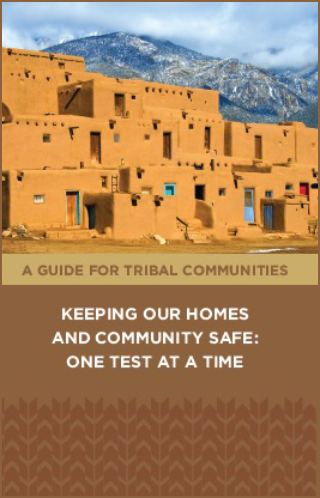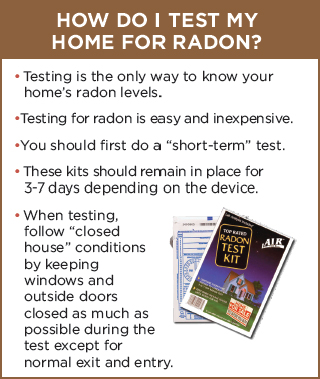Tribal Healthy Homes Project
BACKGROUND
To help address indoor radon concerns and to establish a baseline of general housing conditions, two northern pueblo communities partnered with the Albuquerque Area Southwest Tribal Epidemiology Center (AASTEC) located in Albuquerque, New Mexico. AASTEC epidemiologists collaborated with the health and community services, Indian Health Service Environmental Health Department, health boards, environmental services departments, one housing authority, and the community health representative (CHR) programs in both pueblo communities to help develop an extensive spatial database. We geospatially mapped homes, measured their indoor radon concentrations, and recorded general housing conditions. Prior to the Tribal Healthy Homes Project, each community expressed a desire to apply for environmental health grants. However, existing data were limited on indoor radon measurement as well as current housing conditions. Therefore, this project provided an ideal opportunity for each community to customize and develop a survey of housing attributes and indoor air quality levels; with the end result of an indoor radon dataset as well as in-depth home assessments.
METHODS
As part of the tribal environmental public health tracking program, we facilitated and provided the following services in collaboration with both pueblo communities. First, we participated in determining and prioritizing the health priorities for the overall project. Second, using the established environmental health priority list, we assisted in the development of a customized home assessment data dictionary tailored for conducting home assessments. Third, we provided pilot funds whereby both communities were able to: a) attend a geographical information system (GIS) training at a local tribal community college and b) purchase indoor radon kits and GPS handheld equipment, including essential software licenses. Both communities chose to use a Trimble® handheld device because it is compatible with software capable of easily recording and storing data using the customized home assessment dictionary developed by both tribal communities. The fundamental advantage of using a handheld GPS device lies in its ability to spatially record the location of each home and to record certain housing characteristics, respectively. Fourth, we assisted in developing culturally specific radon brochures for both communities. Lastly, we assisted in training exercises on how to conduct home assessments, how to measure home indoor radon concentration levels, and how to assess homes for fall injury risk factors using an injury prevention checklist.
RESULTS
The project yielded immediate and long-term impacts in both tribal communities.
First, members in each community had the option to expand their technical skillset by learning how to appropriately use a geographical information system database and associated hardware. Prior to the project, some members were beginners and others were more advanced in utilizing GIS software and hardware. Second, both communities spatially mapped and assessed selected homes in their communities. Sample size was based on the population of each tribal community and at the end of the pilot project funding period, each community mapped and assessed nearly half of the homes in their communities. Third, each community was able to attain updated indoor radon concentration measurements picocuries per liter (pCi/L) for both public and residential buildings. As a result, each community is now able to target follow-up testing with homes and buildings with observed higher indoor radon levels above 4.0 pCi/L, the action limit set forth by the Environmental Protection Agency. Fourth, each community was able to capture and record critical housing characteristics including the demographic make-up of residents within each home. For example, the housing department was interested in the number of operating detectors in the home, e.g., smoke and carbon monoxide; the clinical services department was interested in identifying where at-risk populations live within the community, such as children who may have asthma or elderly who require accessibility and mobility assistance.
Long-term impacts of the project include just a few of the following benefits. First, providing opportunities to develop advanced training in utilizing GIS software and hardware will aid in tribal capacity surrounding GIS usage. Second, each community will have spatially mapped homes in their communities, including housing characteristics, recorded as part of the home assessment. Such a map could provide a very powerful tool in prioritizing funds for home repairs, mitigation, and outreach to assist children and elderly in cases of emergencies. Last, homes retested for indoor radon concentration levels observed to be above the action limit could be targeted for home mitigation to reduce indoor radon levels below the action limit. One community is actively querying and utilizing their database to quantify the number of homes with elevated indoor radon levels and the number of home repairs needed to assist at risk populations in their community.
ENVIRONMENTAL HEALTH IMPACT
This project highlights and illustrates impacts of environmental health in several ways. First, the promotion of a healthier environment is a direct impact of the pilot project. By assessing homes for indoor radon levels as well as for housing conditions, tribal housing departments in both communities have information: to target home repairs, to apply for mitigation funds, and to encourage homeowners with potentially elevated indoor radon levels to retest their homes. Second, the availability of a map of geo-located homes along with their respective housing conditions and demographic make-up, would undoubtedly prove useful for public health workers in prioritizing resources in cases of emergencies. Last, the Tribal Healthy Homes project can be used to inform homeowners in both communities on how to create healthier homes to reduce unintentional injuries related to fall risk factors, such as lack of handrails for elderly, or the long-term health effects associated with elevated indoor radon levels.



